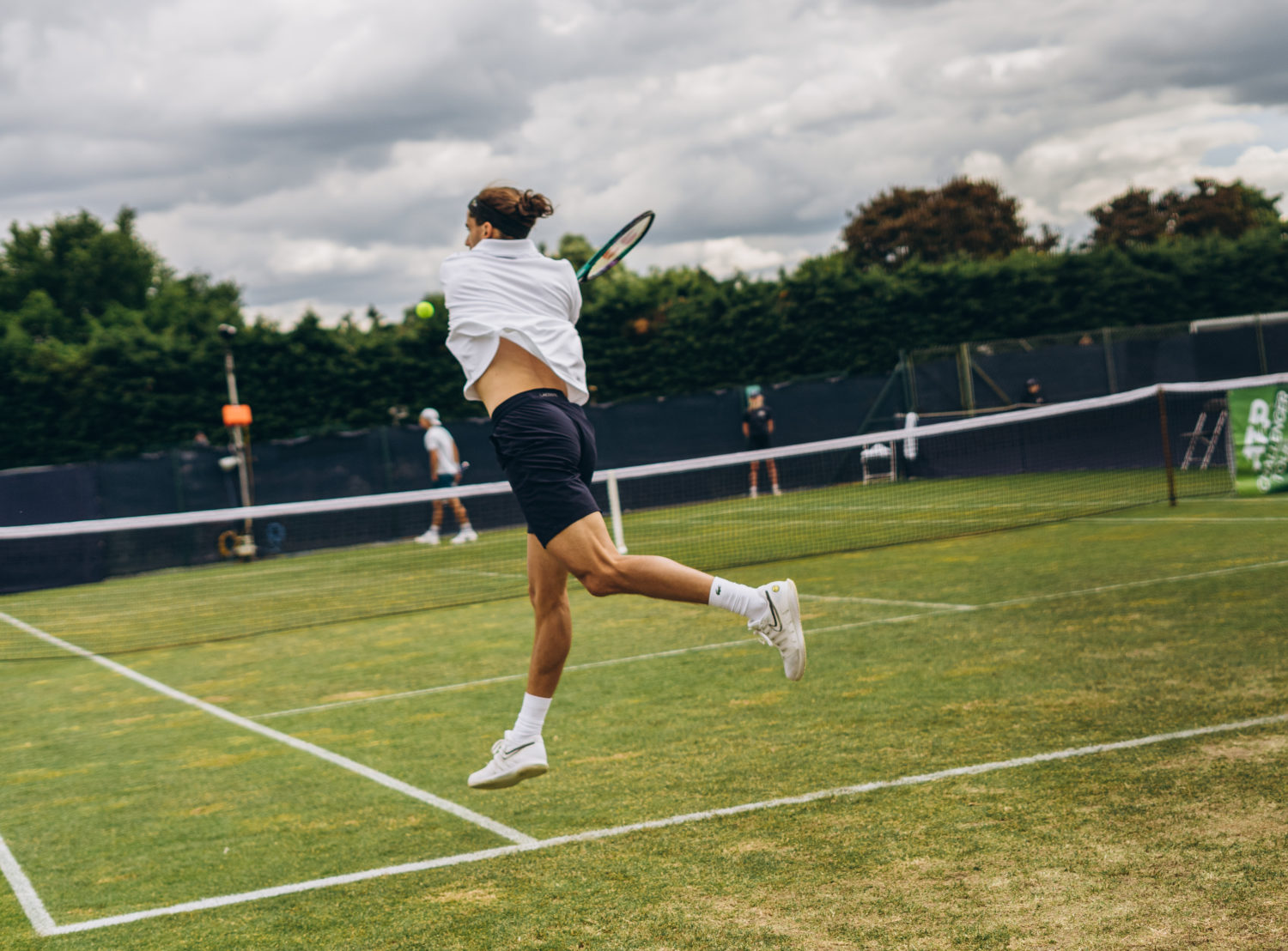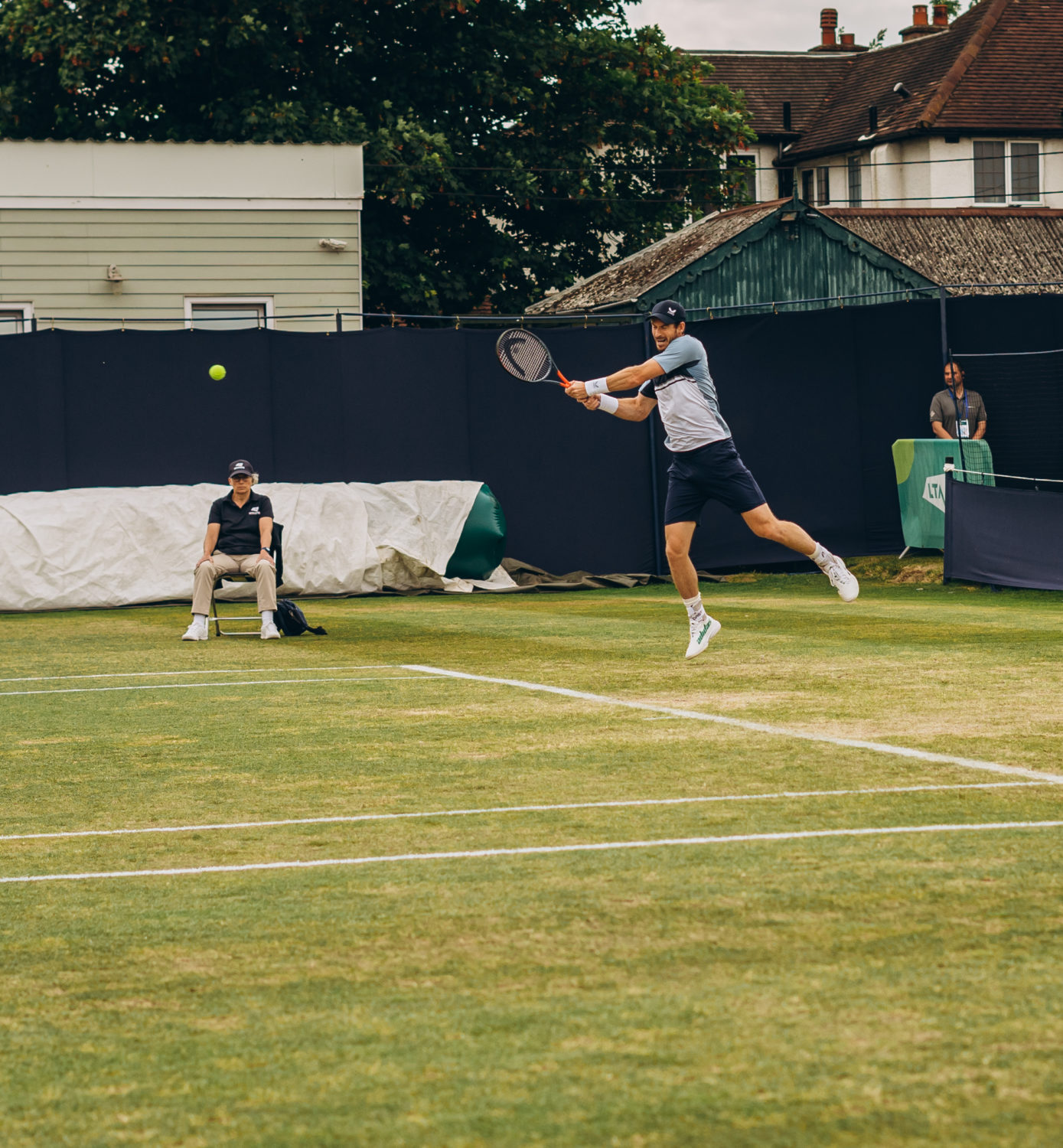An Ode to Surbiton

The ball hit the net. It wasn’t supposed to but it did. Jordan Thompson blinked twice, as if in disbelief, then snarled and chuckled—a sequence of emotions he took a mere second to display. “It’s a joke“, he uttered under his breath. Minutes later, he whipped up an impossibly angled forehand at a full stretch, picking up the ball from inches above the ground, with spin that threatened to send it careening into the stands, but ultimately dragged down to a foot within the baseline. Superhuman as the shot seemed, it was routine, which made the errant forehand from the moment before all the more jarring. In the symphony of a professional tennis match, a missed shot is a false note—it rankles and unnerves. It’s shattered glass. Nails on a chalkboard.
To watch Jordan Thompson in action, the 82nd best male tennis player in the world, is to glimpse how miniscule the technical differences can be between the spotlighted tennis elite and the lower-ranked players that often, and unfairly, make for a backdrop to the matches you see on TV. But to watch him run around the green courts of Surbiton is also to glimpse the essence of grass-tennis in general.
Thompson darts across the baseline with a faint patter of footwork. His game, loaded with looping topspin groundstrokes and cunning slices, extends shots into gruelling rallies.
Inside one such rally, there comes a grunt of strain—his body tenses up for an attacking shot, arm extending—he hits a blistering forehand that wraps around his neck. A quick split step follows, then a gasp, and a sprint across the green for a skilful, put-away volley. The ball slides off his racquet and grazes the side-line of the service box. Or maybe it doesn’t. He freezes, all momentum gone. A linesman shrieks “out!“, and as his voice echoes away, Thompson looks to the spot the ball had just hit, then to the umpire, with a look of utter disbelief on his face. He snarls, irritated, and demands to inspect the ball for signs of chalk which would indicate that the ball had in fact caught the line. He tosses it over in his hands. With his eyes suddenly growing wide, he theatrically drops to his knees. “Oh, come on, he shouts. This is such an important point! You can’t do this.” The umpire shakes his head sympathetically. There’s nothing I can do, he seems to be saying.
Thompson huffs. He shakes his head. He walks over to the service line. Years—decades—of tennis-trained two-second memory doing its work, he’s already pushed the point out of his mind. He’s focusing on the next one.
Thompson plants his feet on the baseline, and looks over to his opponent. He tosses the ball up, and with his gaze fixed on the yellow comet trailing an arch over his head, he hits an ace.
There is no denying that Surbiton is a far cry from the manicured perfection of Wimbledon. But it’s also where grass court tennis gets distilled to its most basic ingredients. It’s a place for the fans to fall in love with the game rather than the sport.
Surbiton Trophy is an annual event taking place in the first week of June. Serving as the entry way into the British grass-court swing, for many players the tournament is often the first contact of the season with grass. Located on the outskirts of London, over its history, the 137-year-old venue has hosted a parade of promising youngsters looking to break through, tour veterans searching for game time, and stars trying to get the feel of the surface they will be playing on for the next month. The ATP website notes that, “Past champions in Surbiton include former Top 10 stars Mardy Fish (2006) and Jo-Wilfried Tsonga (2007), with Lleyton Hewitt and Roger Federer contesting their first professional grass-court matches there in 1998 and 1999, respectively.” The list is not conclusive—Andy Murray competed on multiple occasions, and in 2018, NextGen prodigy, 19-year-old Alex de Minaur, lost in the final to Jérémy Chardy in a three-set thriller.
It takes four minutes and twenty-six seconds to make a full round of the Surbiton Racket & Fitness Club where the event is held. With wet gravel crackling under my shoes, I walk into the tournament grounds past a small and unassuming media centre, then a cordoned-off, low-roofed building serving as the players’ restaurant, and a red-brick clubhouse with bushy, verdant tree line towering over. I go deeper, snaking around the centre court, its makeshift stands creaking under the weight of tennis-hungry fans, and into the open space packed tightly with seven tennis courts—their grass trimmed neatly to three-quarters of an inch. “Please don’t throw stones on the courts“, warns a sign. Which is fitting, seeing as at Surbiton, everything is a stone’s throw away.

I start noticing things—familiar details that one learns to recognise after following live tennis for a while. Groups of ball kids frolicking around as they wait to be called on court (I want to believe that a collective noun for a group of ball kids is a gaggle—it evokes the right kind of sound), officials casting nervous glances at the ominously grey sky, players, easily spotted from the crowd, with their tanned complexions and well-toned frames.
The tournament’s dates fall on the cusp of the British Summer, it is therefore irritatingly cold most of the time. As the week progresses, in a cruel rock-paper-scissors game of weather, I am forced to apply sunscreen just for the rain to wash it off and for the wind to blow the umbrella out of my hand. The lack of glamour of the Surbiton Trophy, and the lower rungs of the tennis tour in general (Surbiton is a Challenger level event—a tier below the ATP Tour), is inescapable—manual scoreboards, chemical toilets, overpriced food. And yet, it has a certain charm to it.
“It doesn’t feel like a Challenger“, Denis Kudla, this year’s finalist, remarked. He is right. This year’s lineup, despite Surbiton Trophy’s modest ranking points offering (however, still more than Wimbledon’s), was packed with tennis-heavyweights. Surrounded by a crowd of onlookers, Andy Murray pinged away volleys on a practice court, tour veterans Radu Albot and Denis Kudla strutted around the grounds, newcomer Brandon Nakashima languidly watched another player’s training session, promising youngster Jack Draper and multiple Slam doubles champion Pierre-Hugues Herbert stretched out on benches and chatted with fans, in a display of access that would be unthinkable just one train-stop away at Wimbledon.
The courts play differently, too. Both Andy Murray and Denis Kudla mentioned it—Murray saying that, “[Surbiton grass] is different to Wimbledon and Queen’s“, and Kudla noting that the courts play “closer to old-school grass than the perfection of Wimbledon.” Over the course of the tournament, the conditions were not always conducive to great hitting, with strong winds and showers interrupting play (“It was a pretty good match considering the ridiculous winds“, said Thompson of his win over Otto Virtanen), but when the elements eased off, and allowed the game to be played, it produced tennis at its most entertaining.
“The clay swing was a little bit rough for me so I was really keen to get started on the lovely green stuff, and it couldn’t have started any better“, Jordan Thompson said of his start to the tournament. In a way, that was my feeling, too. Surbiton Trophy marks the start of the grass-court season, and just as its close cousin, clay, it makes for a unique part of the tennis tour. After the Australian sojourn, the American Sunshine Double, and the Mediterranean clay-swing, I was looking forward to the stoic beauty of “the lovely green stuff“. It seemed fitting, too, that this year, the quintessentially British tournament took place on the Jubilee weekend, an occasion marking Queen Elizabeth’s 70 years of reign.
On the semi-finals day, with the Jubilee flags fluttering over the centre court, I watched Sir Andy Murray battle it out with Denis Kudla. The fans, quieter and more composed than their clay- or hard-court counterparts, applauded genially the low-bouncing rallies, the slices, and the forays to the net. They Ohhd and Ahhd at the falls, slips, and bad bounces, and whispered incredulously at the double faults. The ping and the pong of the ball echoed around the stadium, and Murray’s monologues entertained with a background of constant self-criticism.
At one point, the sun briefly peeked out from behind the clouds, and bathed the Surbiton grass with a golden glow. And as Murray and Kudla went deep into yet another one of their rallies, a smile crept up on my face. The “green stuff” is lovely, I thought.
